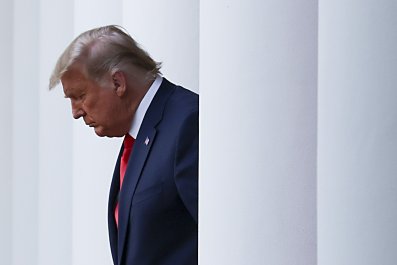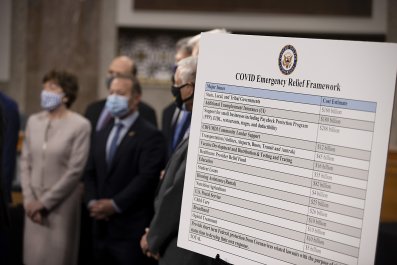Business is booming for the porn industry—on this point, there's no debate.
Its growth over the last few decades has been staggering. From 1988 to 2005, the number of pornographic movies produced each year rose from 1,300 to 13,000. Then came the Internet revolution. By 2019, the web's top pornography site reported 1.36 million hours of new content uploaded that year—more than a day's worth every 10 minutes.
By some estimates, the porn industry is now worth nearly $100 billion, uses more bandwidth than Facebook or Amazon, and has a top site more popular than Netflix.
This explosion of pornography online has been one of the greatest sea changes in our culture's history. In 2006, pornographic tube sites (imagine YouTube, but for porn) showed up online, providing an endless stream of free, high-definition pornographic content of every imaginable kind. With the advent of the smartphone, access to this material is now in everyone's pocket, mere seconds away. Those growing up in this period have consumed more and broader varieties of pornography than ever before.
So what have the effects been, thus far?
Well, a shocking rise in the number of porn addicts, for one. Surveys of teenagers and college students show 60 percent or more admitting to using pornography at least weekly. With recent brain scan surveys, it has become increasingly difficult to classify this type of behavior as anything other than addiction.
And as with any addiction, more and more is required to satisfy the craving. Porn users quickly become desensitized to everyday, "vanilla" sex. In online pornography, everything becomes fetishized (coronavirus-themed pornography appeared almost immediately after the virus itself), and the taboo becomes commonplace. In 2016, "step mom" was the second-most searched for term on Pornhub. "Step sister" and "mom" were fifth and sixth, respectively—slightly less popular than "teen."
Pornography has become increasingly violent, as well. As one 2016 paper relates, "mainstream commercial pornography has coalesced around a relatively homogenous script involving violence and female degradation." Studies find that up to 88 percent of the most popular pornographic videos contain physical violence, and 49 percent contain verbal aggression.
This isn't anything like your father's Playboy.
I spoke to a social worker recently who works with young children—think nine- to 11-year-olds—who have committed sexual abuse, or even sexual crimes. The one thing, I was told, common to all her cases was that the child was a consumer of online pornography. These children, she said, become so addicted that they stay up all night on their iPhones browsing pornographic tube sites. Often, the parents have no idea and hardly know to be worried—they are clueless about what's on these sites and how absurdly easy it is for a child to access them.
The link between porn and childhood sexual dysfunction is more than anecdotal. A 2016 academic review of 20 years of research found that the studies they reviewed "tended to show that adolescents' pornography use was related to," among other things, "a higher likelihood to engage in sexual aggression as well as to experience it, notably among female adolescents."
Another review of 135 studies found "consistent evidence" that porn exposure is directly associated with "higher levels of body dissatisfaction, greater self-objectification, greater support of sexist beliefs and of adversarial sexual beliefs, and greater tolerance of sexual violence toward women." Unsurprisingly, other studies have linked pornography to poor marriage formation and marital quality, extramarital affairs, divorce, breakups and sexual dissatisfaction.
Most distressingly, the growth of the porn industry has also directly led to the exploitation of women and children via sex trafficking. In a recent letter to the Department of Justice, Sen. Ben Sasse (R-NE) documented how Pornhub has been caught hosting content that showed "women and girls [who] were victims of trafficking being raped and exploited." Unfortunately, additional evidence shows this issue goes well beyond Pornhub.
Ubiquitous online pornography, and the ever-growing number of those addicted to it in this country, represents a national emergency. Sixteen states and counting have rightly declared it to be a public health crisis. Yet some, including professed conservatives, say that no government remedy is possible.
Some object that lawmakers can't possibly do anything, since pornography falls under the protections of the First Amendment. Where they get this idea is difficult to say. It's not originalism—obscenity laws are as old as the country. It's not even current Supreme Court precedent. Case after case, including the famous Miller v. California, have affirmed that "obscene material is not protected by the First Amendment."

But, the porn proponents protest, what about Reno v. ACLU? That case struck down the anti-pornography provisions of the Communications Decency Act, the first federal law regulating online pornography. Decided in 1997, one of the key arguments underlying its conclusion was that "the Internet is not as 'invasive' as radio and television." Today, that notion is laughable.
But even in Reno, the Court in a concurring opinion outlined a constitutional path forward for the regulation of pornography: "zoning" the Internet to protect children. They suggested this might work by "requir[ing] Internet users to enter information about themselves—perhaps an adult identification number or a credit card number—before they can access certain areas of cyberspace, much like a bouncer checks a person's driver's license before admitting him to a nightclub."
There's no question that children currently do access pornography online. Studies find that, on average, a child is first exposed to pornography at around 13 years of age. By the time they reach their teenage years, more than a quarter admit that they are seeking out pornography weekly or more often. Exposure to pornography among college-aged males is practically universal. And for every negative effect of pornography on adults, the effect on children is far worse.
The porn industry knows better than anyone that it is providing sexually explicit content to children, but has done next to nothing to stop it. The top porn website conglomerate MindGeek is regularly lauded for its impressive data collection program. Yet it refuses to implement even the barest age verification system to confirm the age of their users. And while the "professionalized" part of the porn industry at least gives the appearance of being responsible and restricting access to minors, the tube sites couldn't care less about you or your kids. Not only do tube sites not verify the age of their viewers, they don't even verify the age of the porn uploaders.
Is this really a responsible system? We don't tolerate this kind of behavior among cigarette distributors, alcohol distributors or gambling sites. We recognize that anyone who knowingly sells these things to a child deserves legal punishment. Why, then, do we simply avert our eyes when it comes to porn?
We have the tools to do otherwise. Current law prohibits the knowing distribution of obscene content to children, and this statute could (and ought to) be applied to porn sites. But it isn't enough. So let's make the law clear: Online pornography distributors ought to implement age verification to prevent children from accessing their material, or otherwise be held liable in court.
The obvious solution is to make Section 230 immunity—which shields porn sites and other Internet companies from civil liability for the content posted on their platforms—conditional on implementing age verification. The broad immunity from prosecution which many porn sites enjoy is a major benefit our government has granted to them. But if porn sites fail in their social obligation to protect children, there's no reason we should continue to allow them to profit from this immunity.
I applaud Brandi for taking a brave stand in favor of age verification measures, even if we disagree on the particulars. She clearly cares deeply about protecting children, and I appreciate her public advocacy in this area. I also appreciate her willingness to engage in this Debate of the Week, in general—these are exactly the types of debates that all Americans need to be having. The explosion of pornography in the Internet era is a massive societal change which, wherever you fall on the issue, deserves thought and care. And we especially cannot afford, as a society, to remain complacent about children's access to pornography.
The reason for complacency thus far has not been a lack of agreement. Restricting underage access to pornography is an incredibly popular position, politically. Not only do Brandi and I agree on it, but a recent poll commissioned by my organization, the American Principles Project, shows the policy is popular with Americans on the whole, as well. Across 7,000 voters in 10 states, 82 percent said they support requiring by law that online porn distributors verify the age of their users. This includes overwhelming majorities across every economic, ethnic, political and ideological subgroup we polled.
Online pornography is clearly a problem. Supporting mandatory age verification for porn sites is a political no-brainer. All that's needed now is a leader with the courage to take it up.
Terry Schilling is the executive director at American Principles Project. Follow him on Twitter: @Schilling1776.
The views expressed in this article are the writer's own.













